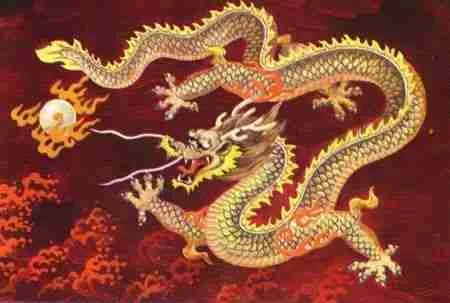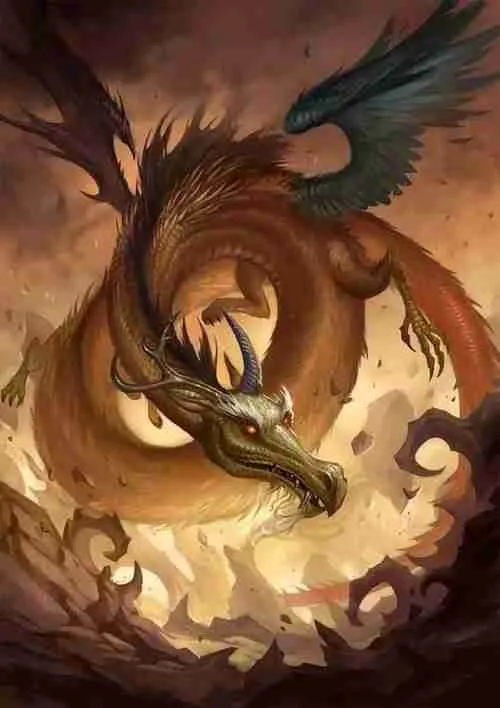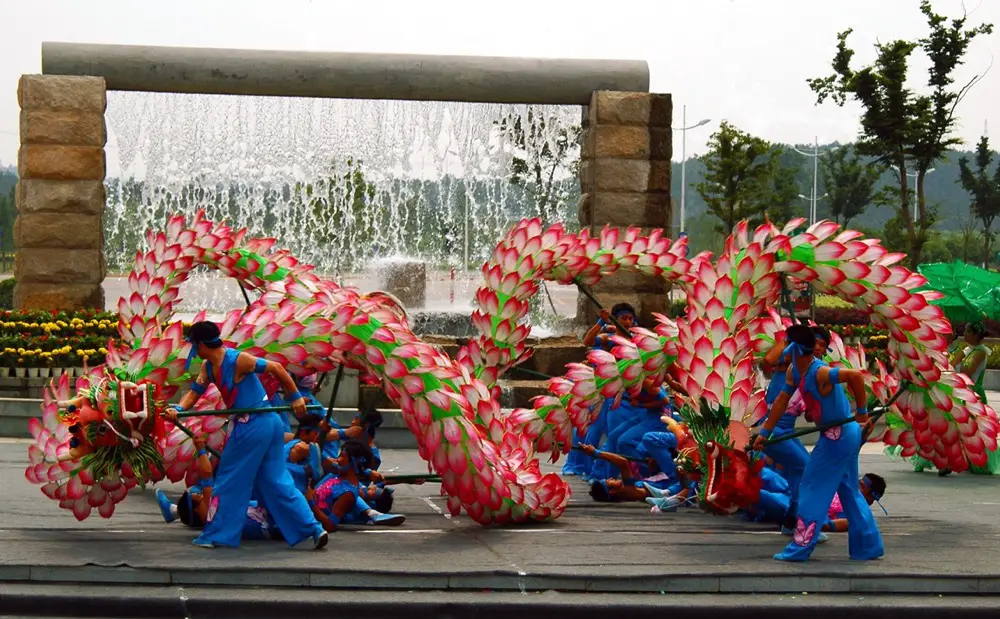The dragon plays an indispensable role in Chinese culture, holding immense significance and a pivotal position. This pertains to influences from various facets like historical legacies, imperial systems, folk beliefs, artistic expressions, and literature. It’s the interweaving and amalgamation of these factors that endow the dragon with profound and extensive connotations within Chinese culture, rendering it a unique emblem and symbol of the Chinese nation.
what are Chinese dragons like
The Chinese dragon, a mysterious and legendary mythical creature, holds an immensely significant position in traditional Chinese culture. According to historical records and folk legends, the Chinese dragon is typically depicted as a long-bodied creature with scales, claws, and the ability to fly or swim.
The dragon’s head is usually large, somewhat square-shaped, occasionally slightly curved. The horns of the dragon come in various forms, resembling antlers, gazelle horns, or even resembling long swords. Typically, the dragon’s forehead bears raised nodules or a third eye, symbolizing divine power. Additionally, the teeth of the dragon are vital; some have sharply pointed teeth, while others possess long, curved teeth, displaying formidable biting force.

Among its most distinctive features are the dragon’s scales, which cover various parts of its body, especially the back and abdomen. The scales vary in size, shape, and color, ranging from golden yellow to reddish or deep green. They shimmer in the sunlight, giving off a mysterious and magnificent aura.
The dragon’s limbs are robust and powerful, equipped with sharp claws on both front and hind legs, suitable for crawling on the ground or climbing. Its tail is typically long, snakelike, often ending in sharp spikes or nodules. The tail not only aids the dragon in swimming but also serves as crucial support for its flight.
Beyond its physical attributes, the dragon’s inner divinity is revered. In traditional Chinese culture, the dragon is seen as a symbol of auspiciousness, strength, and dignity. Its divine power is believed to control the weather, ward off evil, and bring prosperity and good fortune. Hence, the dragon’s imagery is frequently utilized in architecture, painting, sculpture, literature, and folklore.
Throughout China’s extensive history, the perception of the dragon has evolved with changing times. In ancient times, the dragon was often a symbol of royalty, representing supreme authority and dignity. The emperor’s attire, palaces, and objects were adorned with dragon patterns and imagery, symbolizing royal prestige and authority. In folk beliefs, the dragon was regarded as a deity that safeguarded family well-being and ensured success in endeavors. Various rituals were performed to seek the dragon’s blessings and protection, such as the “Dragon Worship” ceremony on the first day of the lunar calendar or dragon boat races during the Dragon Boat Festival.
In addition to the traditional Chinese dragon imagery, modern artists are exploring and innovating, displaying the Chinese dragon’s versatility and rich symbolism. These contemporary works retain traces of traditional elements while infusing new creativity and aesthetic concepts. For instance, some modern sculptures combine the dragon’s form with abstract art, presenting a unique visual effect. Other artists attempt to merge dragon elements with other cultural symbols to create a more diverse artistic style.
what do Chinese dragons represent
The Chinese dragon carries diverse and rich symbolic meanings in China, and its deep historical and cultural significance makes this mythical creature a crucial representative of Chinese civilization. Here are detailed enumerations of the dragon’s major symbolic meanings in China:
Authority and Imperial Power: The dragon in Chinese tradition is closely linked with imperial authority. The emperor is referred to as the “true dragon son of heaven,” representing the divine mandate, symbolizing the highest authority. Dragon motifs and imagery abound within the imperial palace, emphasizing the royal dignity and sanctity. This symbolism has deeply influenced people’s perceptions and continues to do so today.
Auspiciousness and Prosperity: In Chinese culture, the dragon symbolizes auspiciousness, prosperity, and abundance. It is believed to control the weather, bringing rainfall to ensure bountiful harvests. Hence, during significant agricultural periods like spring planting or autumn harvest, people hold dragon-worship ceremonies, seeking prosperity and good fortune. In daily life, phrases and symbols associated with the dragon, such as “dragon soars, tiger leaps” or “vigorous as a dragon and horse,” convey good luck and a positive spirit.
Wisdom and Strength: The Chinese dragon is often portrayed as a fusion of wisdom and strength. Its mysterious and powerful nature embodies courage, intelligence, and strength. In many stories, the dragon represents bravery and intelligence, triumphing over evil forces to protect the weak. This symbolism of wisdom and strength inspires people to bravely face challenges and solve problems using wisdom.
Unity and National Identity: As a symbol of Chinese culture, the dragon represents the unity and identity of the entire nation. Both domestically and internationally, the dragon emblem symbolizes the unity of Chinese culture and the Chinese nation. During significant festivals or celebrations, activities like dragon dances or dragon boat races reinforce people’s sense of belonging and cultural identity.
Artistic and Cultural Carrier: The dragon’s imagery finds extensive application in Chinese arts and literature. From ancient paintings and sculptures to modern film and television productions, the dragon remains a vital source of artistic inspiration. The dragon’s image not only showcases the unique charm of Chinese culture but also embodies the artistic and spiritual pursuits of the Chinese people.
why dragons are important in the Chinese culture
The dragon holds an immensely significant position within Chinese culture, influenced by a multitude of factors. Here is a detailed analysis of why the dragon is crucial in China:
Link to Historical Heritage:
The dragon, a core element of Chinese traditional culture, has existed for thousands of years. It stems from ancient reverence and worship for natural forces, serving as a collective memory and link to historical legacy within Chinese civilization. Across the vast expanse of Chinese history, the dragon’s imagery and tales have been passed down, becoming an integral part of Chinese culture’s inheritance and evolution.
Imperial Power and National Emblem:
In the feudal society of ancient China, the dragon symbolized royal authority, representing supreme power and dignity. Emperors referred to themselves as “true dragon sons of heaven,” signifying their divine rule over the realm. This system persisted for millennia, with dragon motifs adorning imperial attire, palaces, and artifacts, showcasing royal prestige and authority. The reverence and faith in dragons by the populace reflected aspirations for national prosperity and unity.
Folk Beliefs and Cultural Symbolism:

Beyond its role in royal culture, the dragon has extensive influence in folk beliefs. People believe in the dragon’s divine power, seeking blessings for family safety and successful endeavors. Traditional ceremonies during significant Chinese festivals, such as “dragon worship” on the first day of the lunar year or dragon boat races during the Dragon Boat Festival, symbolize auspiciousness and well-being. The dragon’s imagery is widespread in architecture, sculpture, painting, and literary works, becoming a crucial symbol of Chinese culture.
Symbol of National Identity and Unity:
As a symbol of the Chinese nation, the dragon holds an irreplaceable position. The dragon culture in China has a deep-rooted and widespread mythological belief system. This worship and faith have become an integral part of maintaining national unity and cohesion, both domestically and internationally. The dragon emblem signifies the unity of Chinese culture and the Chinese people.
Source of Artistic Inspiration and Cultural Influence:
The dragon’s image and symbolism find extensive application and development in Chinese arts and literature. From ancient poetry and paintings to modern film and television, the dragon remains a vital source of artistic and literary inspiration. Its multifaceted symbolism, representing strength, dignity, and aspirations for a better life, has contributed substantially to various forms of art and literature.
Modern Cultural Symbol in Contemporary Society:
Despite societal changes, the dragon’s auspicious significance continues in modern China. Its image is widely used in commerce, branding, and cultural innovation. For instance, in China’s tourism industry, the dragon’s image serves as a significant cultural symbol, attracting visitors worldwide. In literature, film, and art, the dragon’s image appears frequently, imbued with new meanings and interpretations.
why do Chinese use dragons
The reasons why Chinese people favor the use of dragons are multifaceted, rooted in deep historical and cultural significance and national sentiments.
Firstly, dragons in Chinese culture symbolize auspiciousness, prosperity, and strength. As mythical creatures, dragons were believed to control weather elements, ensuring abundant harvests by bringing rain to the land. Consequently, the dragon’s image held immense reverence and belief among people in agrarian societies. It was associated with bringing good luck and prosperity, prompting rituals such as dragon worship and dragon dances during significant occasions. Furthermore, the dragon’s portrayal as a symbol of power and independence aligns with the Chinese pursuit of self-reliance and resilience as a nation.

Secondly, as a representative element of Chinese culture, the dragon holds widespread influence. Its image finds extensive application in architecture, sculptures, paintings, literature, and various artistic domains. For instance, within ancient royal palaces and temples, elaborate dragon motifs and imagery adorned walls and structures, signifying regal prestige and authority. Moreover, in literary works and folk tales, dragons often serve as protagonists or pivotal characters, enriching storylines and characterizations. These creations convey the mystical power and noble character of the dragon, imparting the values and spiritual essence of Chinese culture.
Thirdly, as a symbol of the Chinese nation, the dragon embodies national identity and unity. Throughout China’s history, the dragon has been an essential emblem of political authority and social stability. Emperors proclaimed themselves as the “true dragon son of heaven,” representing divine mandate and supreme rule. This imperial system persisted for millennia, solidifying the dragon’s representation of political stability and social order. In folk beliefs, the dragon is revered as a guardian spirit, believed to safeguard family well-being and success. Ceremonies like dragon worship and dragon dances continue in modern society, reinforcing a sense of belonging and cultural identity.
In summary, the Chinese preference for employing dragons is rooted in their symbolism of auspiciousness, prosperity, and strength, coupled with their status as a representative cultural element and symbol of the Chinese nation. This profound reverence for and belief in dragons have deeply resonated, serving as a crucial link in maintaining national unity and cultural heritage.
Conclusion
In summary, the significance of the dragon in Chinese culture is multifaceted. It serves as a link to historical legacies, symbolizing imperial authority and national identity. Additionally, it embodies folk beliefs and cultural symbolism, carrying people’s faith and aspirations. Furthermore, it acts as a wellspring of inspiration for arts, literature, and a cultural symbol in modern society. Its auspicious symbolic meaning is influenced by multiple factors like history, culture, and society, evolving with the passage of time. For the Chinese, the dragon is not merely a mythical figure or cultural emblem but a spiritual sanctuary and an expression of national sentiment. Whether in ancient times or the present day, the dragon represents the essence and continuity of Chinese culture, an integral part residing deep within the hearts of the Chinese people.